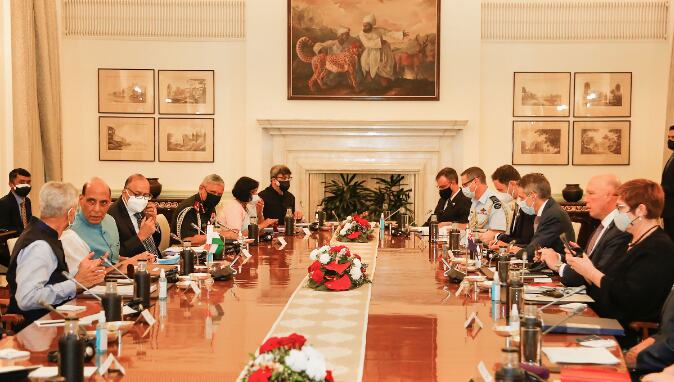Boosting bilateral ties
A fortnight ahead of the in-person Quad summit, the 2+2 minister-level meet between India and Australia hinged upon the core objectives of the grouping

The recent 2+2 of Minister-level meeting between India and Australia completes the set of such engagements the members of the Quad are having bilaterally with one another. The first such exercise India had was with Japan later on with the United States and now with Australia, all of whom are also working closely in the Indo-Pacific region.
Taking forward the bilateral Comprehensive Strategic Partnership, the Foreign and Defence Ministers of both countries drew a roadmap encompassing political, economic, security and defence-related issues underscoring the importance of "advancing their shared objectives of an open, free, prosperous and rule-based Indo-Pacific region, in line with India increased engagement" in this sphere.
As External Affairs Minister S. Jaishankar and Defence Minister Rajanth Singh met Australian Foreign Minister Marise Payne and Defence Minister Peter Dutton for the first 2+2 meeting in the backdrop of the continuing grip Covid19, it was natural for the leaders to devote time to review work in this area, specially crafted under the Quad framework.
The September 11 2+2 Ministerial level meeting came a fortnight ahead of the first Quad in-person Summit scheduled at Washington DC. At the virtual leaders' meeting earlier this year, the formation agreed to produce vaccines for countries in the Indo-Pacific with India as its manufacturer, Australia providing the logistics to supply these and the rest two the United States and Japan providing funds for the project.
For the present, the project targeted to come into operation by the end of next year is on a slow track as India focuses on vaccinating its population on priority after putting on hold its Vaccine Maitiri initiative. What is moving is research in both countries working to study the effects of the virus on future health, prevent and respond to reduce risks from future pandemics under the Australia-Indian Strategic Research Fund.
One important component of bilateral, Quad and multi-lateral engagements is the aggressive attitude of China, which is gradually seeking to expand its global footprint. The trade showdown during President Trump's era, the outbreak of Covid-19 and the near-total shutdown of supplies from China last year made the world realise what dependence on one country can prove counterproductive. The accent since then is to develop alternate resilient supply chains and India remains an important hub in this new calculation.
A crucial factor in India-Australia bilateral relations that witnessed a quantum leap is in the area of defence. After the country pulled out from Malabar five-nation naval exercise in 2007, Australia was readmitted and took part in the first phase of the exercise hosted during August by the United States off the coast of Guam. This war-game exercise allows the Navies of India, Australia, Japan and the United States to demonstrate, coordination, synergy and inter-operability of the four countries on the high seas.
With India assiduously working on its Atmanirbhar plan and promoting defence manufacturing in the country, the move to further research in this strategic field through India's Defence Research Development Organisation and Defence Science and Technology Group of Australia would allow both countries to explore new frontiers in critical technology amid India seeking access to source rare earth material from the country.
After years of being wrapped in the world of Cricket, Curry and Commonwealth, the bilateral relations began to turn around the beginning of this century as both sides began to look at relations through global commons – the vast oceans that connect, encouraged by the changing nature of India-US ties and altering equations with China, whose rise continues to be a cause for concern.
That the United States remains a factor in Australian geostrategic calculations is known as the countries' waters of the Pacific lap the shores of either country. The latest announcement of the creation of AUKUS, a new enhanced security and defence partnership in the Indo-Pacific region among Australia, the United Kingdom and the United States reiterates this.
Interestingly while the establishment and political system in Australia started paying greater attention to India, the latest poll by Australian think-tank, Lowy Institute, showed that the public opinion in this regard is just about growing. It said 61 per cent of Australians today trust India a "great deal/act responsibly" which is on par with the United States. The poll findings showed that the quotient went up by 16 percentage points as compared to the previous year. It said over 50 per cent of Australians continued to display "warm feelings" towards India. The place where the Indian rating is low among Australians is New Delhi not doing enough to combat climate change. For a country whose governments were mindful of China, the poll showed that the overwhelming majority today lost trust in Beijing and viewed it as an economic threat to Australia. The current geopolitical situation in the region accentuated by the dramatic developments in Afghanistan where China seeks a greater role just adds a new dimension.
Views expressed are personal



